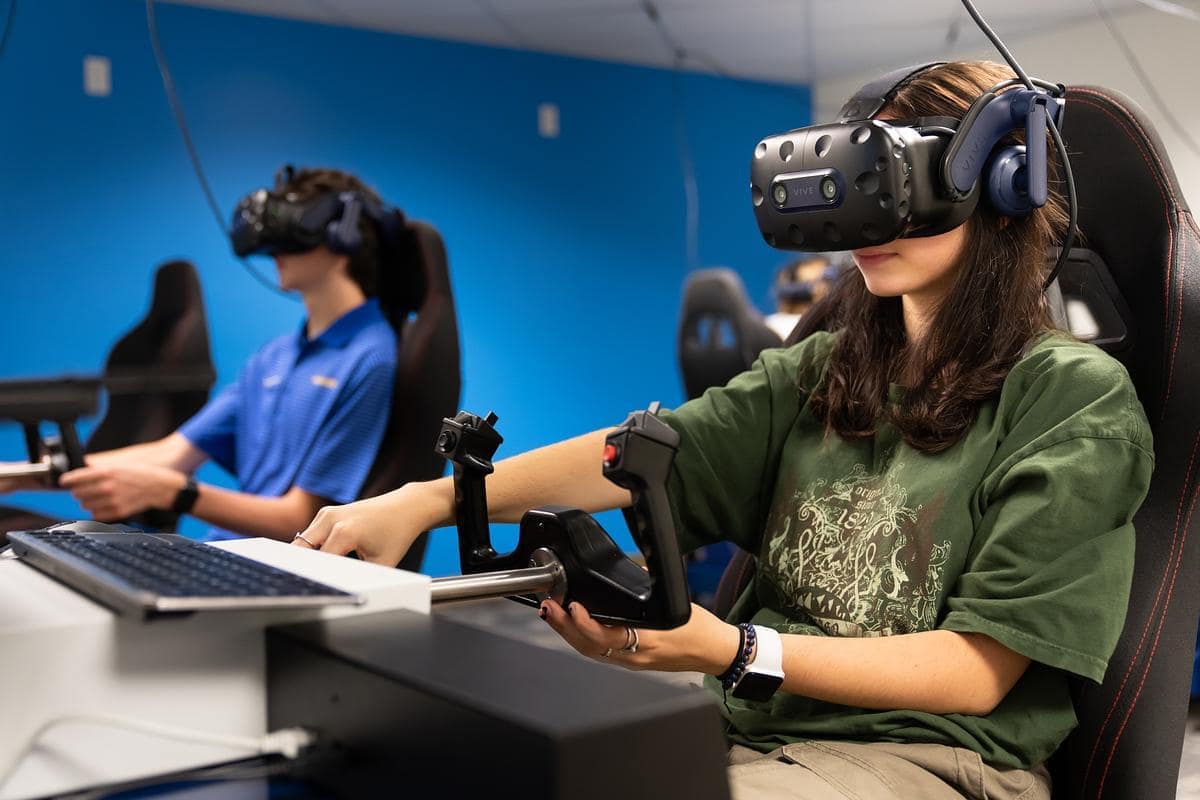Aviation Week Op-Ed: Virtual Systems Improve Training and Safety

This Aviation Week op-ed underscores the value of extended reality technologies for aerospace workforce training and safety. Embry-Riddle Aeronautical University President P. Barry Butler, Ph.D., points to how virtual, augmented, and mixed reality technologies are being used to train maintenance technicians and prepare students for everything from their first flight to spatial disorientation. This essay — published in May 2021 — is available to read at the Aviation Week website and below.
By P. Barry Butler
The aviation industry faces multiple urgent safety challenges. As pilots furloughed during the pandemic return to flight decks, for example, how can we ensure that their skills remain fresh? What is the best way to teach technicians to identify damaged turbine blades? Is it possible to better prepare pilots for spatial disorientation in the air?
Extended reality or “XR” systems — based on a mix of virtual, augmented and mixed reality technologies — suggest a way to address key safety and workforce-training challenges. Although XR systems will never replace highly skilled instructors, they have proven to be very effective teaching tools when used properly – particularly for the next generation of pilots and technicians. The technology is available at a wide range of price points, too, depending on the nature of the training.
Ever since the first Link Trainers were used to prepare pilots for World War II, simulation has played an important role in aviation education. Nevertheless, there were undoubtedly those who believed a simulator could ever replace time in the air. Though sophisticated for its time, an ANT-18 Blue Box Link Trainer on display at Embry-Riddle now looks somewhat like a carnival ride parked beside a full motion flight simulator. The display is intended to show students how far we’ve come in advancing simulation technology.
Simulation training tools became even more important in 2020, especially for aspiring aviation mechanics. Under heightened Covid-19 protocols, many FAA Part 147 universities received FAA approvals to offer online learning coupled with lab experiences. Being able to incorporate XR training into online technician training proved beneficial and we envision that the technology will either augment or replace some of the complex laboratory student projects we currently perform. The promise of simulating aircraft maintenance operations at the same level as pilots now seems within reach.
Recently, I had an opportunity to don virtual reality goggles in an XR lab so that I could see first-hand how students are touring a simulated turbine engine to check for defects in fan blades. In the same lab, using the exact same equipment, student pilots familiarize themselves with a pre-flight checklist by walking around a virtual Cessna 172 on a ramp that looks exactly like the real thing. Would-be astronauts in our Spaceflight Operations program can virtually explore and even perform repairs aboard a simulated International Space Station (ISS).
Researchers in the same building are meanwhile inventing a low-cost version of a spatial disorientation trainer, a high-end piece of equipment that may be prohibitively expensive for many flight-training programs. Combining motion simulation and virtual reality, the aviation illusion trainer now under development will subject student pilots to a deadly yet common scenario – a sudden transition from visual to instrument meteorological conditions.
We are not leveraging these teaching tools simply because they are fun and today’s students grew up playing video games. Research has shown that virtual, mixed, and extended reality training tools work well within the context of a holistic educational program, under the guidance of skilled instructors. In a 2018 study by Jennifer Lewis and Joyner Livingston of SAIC, for instance, immersive synthetic training environment simulators helped student pilots complete their first successful solo flight in roughly half the time. At my school, we are conducting rigorous pre- and post-assessments of XR training participants to gauge learning efficacy.
Evidence-based validation of virtual, augmented, and mixed reality training technologies – including computer-based systems and haptic feedback devices – will be an essential step in expanding their use.
We can get there. Simulation training tools are widely accepted in the medical and industrial fields. Healthcare workers are leveraging visualization training to better understand human anatomy and prepare for complex surgeries.
XR systems support the safe, efficient training of new talent – for both flight and space travel.
For aviation maintenance professionals, XR minimizes expensive mistakes and allows students to perform invasive procedures without jeopardizing safety. For aspiring pilots, high-fidelity interactive XR environments make it possible to prepare for dangerous scenarios in the air. The technology also allows students to complete assignments remotely – a major plus during a global pandemic – at minimal cost.
Research-based validation of XR training tools will be key to their advancement.
